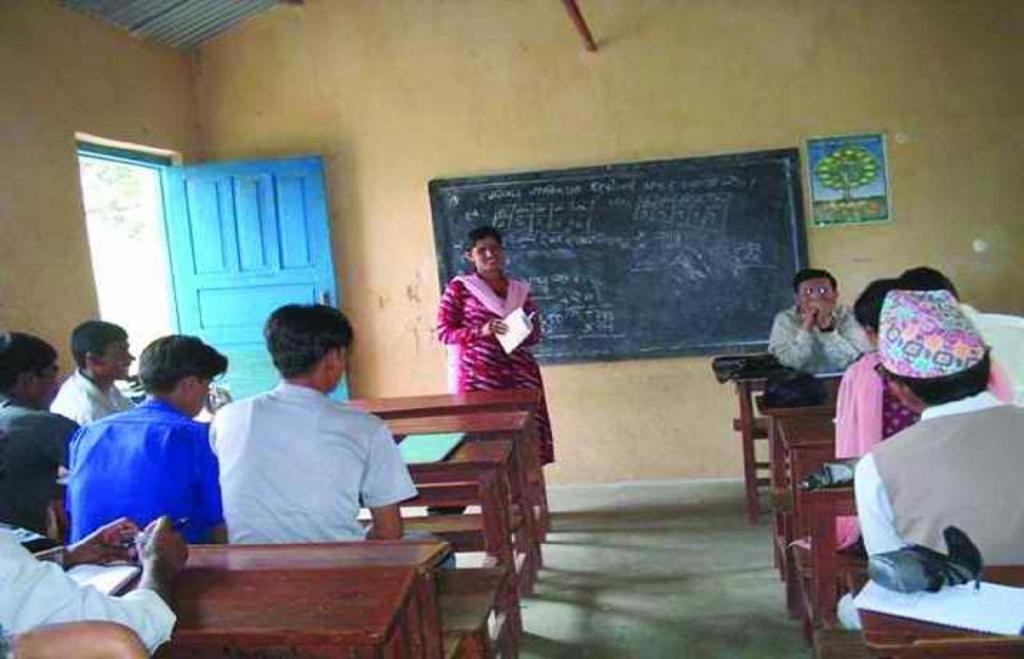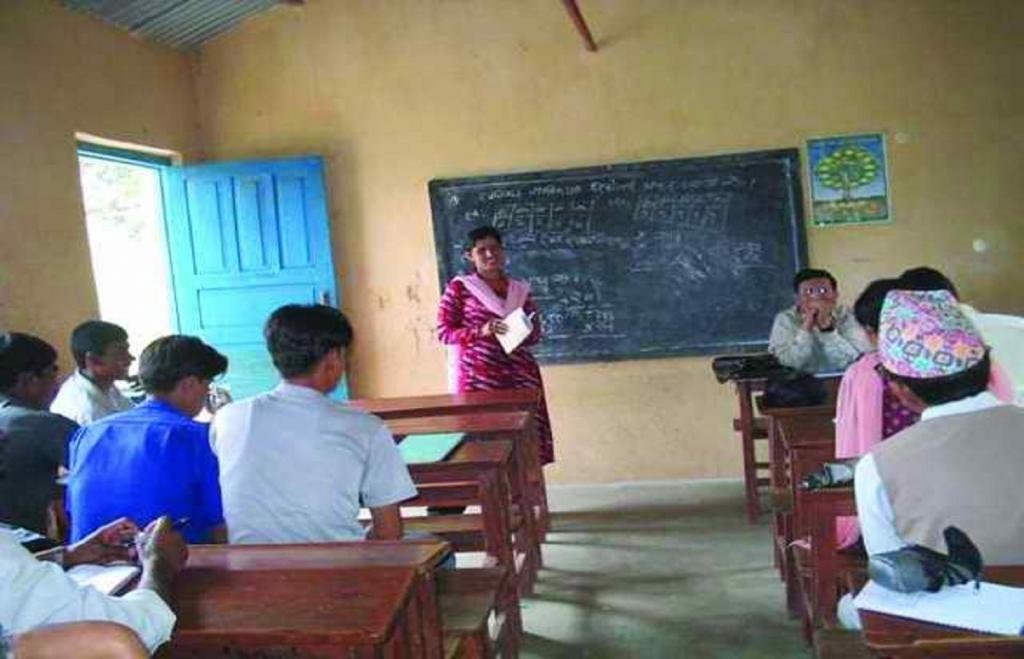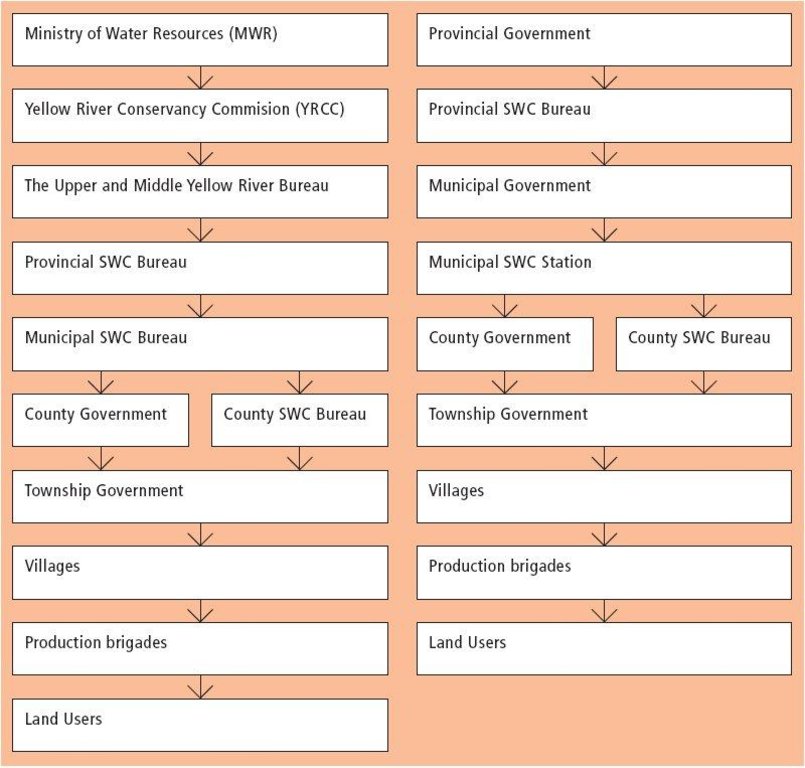Terrace approach [ប្រទេសចិន]
- ការបង្កើត៖
- បច្ចុប្បន្នភាព
- អ្នកចងក្រង៖ Yaolin Wang
- អ្នកកែសម្រួល៖ –
- អ្នកត្រួតពិនិត្យច្រើនទៀត៖ Laura Ebneter, Deborah Niggli
approaches_2399 - ប្រទេសចិន
ពិនិត្យមើលគ្រប់ផ្នែក
ពង្រីកមើលទាំងអស់ បង្រួមទាំងអស់1. ព័ត៌មានទូទៅ
1.2 ព័ត៌មានលម្អិតពីបុគ្គលសំខាន់ៗ និងស្ថាប័នដែលចូលរួមក្នុងការវាយតម្លៃ និងចងក្រងឯកសារនៃវិធីសាស្ត្រផ្សព្វផ្សាយ
អ្នកជំនាញឯកទេស SLM:
អ្នកប្រើប្រាស់ដី:
អ្នកជំនាញឯកទេស SLM:
អ្នកជំនាញឯកទេស SLM:
ឈ្មោះគម្រោងដែលបានចងក្រងឯកសារ/ វាយតម្លៃលើវិធីសាស្ត្រផ្សព្វផ្សាយ (បើទាក់ទង)
Book project: where the land is greener - Case Studies and Analysis of Soil and Water Conservation Initiatives Worldwide (where the land is greener)ឈ្មោះអង្គភាពមួយ (ច្រើន) ដែលបានចងក្រងឯកសារ/ វាយតម្លៃលើវិធីសាស្ត្រផ្សព្វផ្សាយ (បើទាក់ទង)
Department of Resources and Environmental Science, Beijing Normal University (Department of Resources and Environmental Science, Beijing Normal University) - ប្រទេសចិនឈ្មោះអង្គភាពមួយ (ច្រើន) ដែលបានចងក្រងឯកសារ/ វាយតម្លៃលើវិធីសាស្ត្រផ្សព្វផ្សាយ (បើទាក់ទង)
ISRIC World Soil Information (ISRIC World Soil Information) - ប្រទេសហូឡង់ឈ្មោះអង្គភាពមួយ (ច្រើន) ដែលបានចងក្រងឯកសារ/ វាយតម្លៃលើវិធីសាស្ត្រផ្សព្វផ្សាយ (បើទាក់ទង)
GEF/OP12 Gansu Project (GEF/OP12 Gansu Project) - ប្រទេសចិន1.3 លក្ខខណ្ឌទាក់ទងទៅនឹងការប្រើប្រាស់ទិន្នន័យដែលបានចងក្រងតាមរយៈវ៉ូខេត
អ្នកចងក្រង និង(បុគ្គលសំខាន់ៗ)យល់ព្រមទទួលយកនូវលក្ខខណ្ឌនានាទាក់ទងទៅនឹងការប្រើប្រាស់ទិន្នន័យដែលបានចងក្រងតាមរយៈ វ៉ូខេត:
បាទ/ចា៎
1.4 ការយោងមួយ (ច្រើន) ទៅលើ (កម្រង) បញ្ជីសំណួរនៃបច្ចេកទេស SLM
2. ការពណ៌នាអំពីវិធីសាស្ត្រផ្សព្វផ្សាយ SLM
2.1 ពណ៌នាសង្ខេបខ្លីពីវិធីសាស្ត្រផ្សព្វផ្សាយ
Highly organised campaign to assist land users in creating terraces: support and planning from national down to local level.
2.2 ពណ៌នាលម្អិតពិវិធីសាស្ត្រផ្សព្វផ្សាយ
ពណ៌នាលម្អិតពិវិធីសាស្ត្រផ្សព្វផ្សាយ:
Before 1964, the slopes on China's Loess Plateau were cultivated up and down by machinery. Consequently soil and water were lost at high rates, and fertility and yields declined. Accessibility to cultivated land became more and more difficult due to dissection by gullies. The first terraces were established by self-mobilisation of the local land users. However there was no standard design. Furthermore, as the individual plots were very small and scattered all over the village land, terracing needed better coordination. Between 1964 and 1978, the local government at the county level took the initiative of organising farmers and planning terrace implementation according to specific technical design on a larger scale. At that time the land was still communally managed by production brigades. Through mass mobilisation campaigns people from several villages were organised to collectively terrace the land - village by village - covering around 2,000 hectares each year. Labour was unpaid.The Yellow River Conservancy Commission (YRCC) came into being in 1948 - and the Upper and Middle Yellow River Bureau in 1977. This gave greater impetus to the implementation of SWC in the Loess Plateau. After 1978, land use rights were allocated to individuals (though official ownership was still vested in the state). SWC specialists and county level SWC bureaus started to work with groups of farmers who had land use rights within a given area. Survey and design were carried out. The farmers organised themselves, consolidated the parcels of land, and then after the conservation work was done they redistributed the terraced fields.
In the 1980s the government started to financially support land users involved in SWC projects. Subsidies ranged from (approx.) US$* 20/ha in projects at county level, to US$* 55/ha for national projects (eg through the Yellow River Commission), and up to US$* 935/ha when World Bank projects were involved - as in the recent past. Implements were provided by the farmers themselves. Then, in 1988 a nationwide project in SWC - which originally was proposed at county level - was approved by the national government. Furthermore, in 1991 a national law on SWC came into force. Protection of the Yellow River and associated dams became a priority at regional and national levels. In total, within Zhuanglang County, 60 SWC specialists/extensionists cover an area of 1,550 km2, and most of the terraces were built with low levels of subsidies. Annual plans about implementation of new SWC measures were made during summer. Small areas were planned at village or township level, whereas bigger areas (> 7 hectares) were designed at county level. Implementation then took place during winter. Terracing was implemented first where access was easiest and closest to settlements, and only later, further away. * exchange rate: 1 US$ = 8 Chinese Yuan (May 2006).
2.3 រូបភាពនៃវិធីសាស្ត្រផ្សព្វផ្សាយ
2.5 ប្រទេស/តំបន់/ទីតាំងកន្លែង ដែលវិធីសាស្ត្រផ្សព្វផ្សាយត្រូវបានអនុវត្តន៍
ប្រទេស:
ប្រទេសចិន
តំបន់/រដ្ឋ/ខេត្ត:
Gansu Province, Loess Plateau Region
Map
×2.6 កាលបរិច្ឆេទនៃការចាប់ផ្តើម និងបញ្ចប់នៃវិធីសាស្រ្តផ្សព្វផ្សាយនេះ
សូមបញ្ជាក់ឆ្នាំដែលបានបង្កើតឡើង:
1964
2.7 ប្រភេទនៃវិធីសាស្ត្រផ្សព្វផ្សាយ
- ផ្អែកលើគម្រោង/កម្មវិធី
2.8 គោលបំណង/ទិសដៅសំខាន់នៃវិធីសាស្ត្រផ្សព្វផ្សាយ
Aims of the approach are: - water conservation (this is a semi-arid area), - soil conservation: reduce soil loss on the sloping and erosion-prone land of loess plateau, - enhancing soil fertility, and consequently production, - improve people's living conditions, These primary objectives were to be achieved by building level bench terraces on a large scale through a structured and organised campaign. Finally at the national level, a fourth aim was added: the protection of the Yellow river (avoiding floods and reducing the sediment load)
The SLM Approach addressed the following problems: - lack of organisation, capital and technical knowledge in farmer communities to counter the underlying problems of water loss, soil loss, fertility decline and downstream effects on the Yellow River (floods and sediment) at catchment level, - absence or poor maintenance of erosion control measures
2.9 លក្ខខណ្ឌអនុញ្ញាត ឬរារាំងការអនុវត្តន៍បច្ចេកទេសដែលស្ថិតនៅក្រោមវិធីសាស្រ្តផ្សព្វផ្សាយ
ភាពអាចរកបាននៃធនធានហិរញ្ញវត្ថុ និងសេវាកម្ម
- រារាំង
Initially farmers were not paid and as they had no immediate benefit from, or security over, the use of the land. The investment in construction was a heavy burden on poor farmers.
Treatment through the SLM Approach: After 1988, labour inputs by farmers started to be partly covered by subsidies provided by local and national government
ក្របខណ្ឌច្បាប់ (សិទ្ធិកាន់កាប់ដីធ្លី កម្មសិទ្ធីប្រើប្រាស់ដីនិងទឹក)
- រារាំង
Land users leased the land from the state and land users??? rights were insecure in the long term. Investments in SWC were not encouraged.
Treatment through the SLM Approach: National government persuaded land users to implement terraces by 'selling' the benefits (increased yield and easier workability of the land). After 1978, individual user rights motivated farmers to invest in SWC.
The existing land ownership, land use rights / water rights hindered a little the approach implementation Ownership of land and its resources belongs to state and communities: land users only lease the land for a period of time. Due to uncertainty over future user rights and possible reallocation in response to changes in population and household needs, additional investments into measures may be hindered. 1978 a first major change took place by allocating some individual land use rights.
ចំណេះដឹងស្តីពី SLM និងការទទួលបានការគាំទ្រផ្នែកបច្ចេកទេស
- រារាំង
Poor knowledge of how to reduce water loss, soil loss and fertility loss. Technical solutions were needed at the catchment level, involving the whole population.
Treatment through the SLM Approach: Enhanced guidance by SWC specialists.
3. ការចូលរួម និងតួនាទីរបស់ភាគីពាក់ព័ន្ធ
3.1 អ្នកពាក់ព័ន្ធដែលបានចូលរួមក្នុងវិធីសាស្ត្រផ្សព្វផ្សាយ និងតួនាទីរបស់ពួកគេ
- អ្នកប្រើប្រាស់ដីក្នុងតំបន់/សហគមន៍
- រដ្ឋាភិបាលថ្នាក់ជាតិ (អ្នករៀបចំផែនការ អ្នកសម្រេចចិត្ត)
3.2 ការចូលរួមរបស់អ្នកប្រើប្រាស់ដីក្នុងតំបន់/ សហគមន៍ក្នុងតំបន់ក្នុងដំណាក់កាលផ្សេងគ្នានៃវិធីសាស្រ្តផ្សព្វផ្សាយ
| ការចូលរួមរបស់អ្នកប្រើប្រាស់ដីក្នុងតំបន់/សហគមន៍ក្នុងតំបន់ | សូមបញ្ជាក់នរណាត្រូវបានចូលរួម ព្រមទាំងពណ៌នាសកម្មភាពទាំងនោះ | |
|---|---|---|
| ការចាប់ផ្តើម/ការលើកទឹកចិត្ត | អន្តរកម្ម | Land users started implementing terraces but SWC specialists at the country level assisted in designing standards for terrace construction and township governments and production brigades organised whole villages and watersheds |
| ការរៀបចំផែនការ | អសកម្ម | Being consulted in the planning phase. Experienced peasants may be involved in introducing the local situation. |
| ការអនុវត្តន៍ | អន្តរកម្ម | Major organisation done through the SWC bureau specialists with the village organisation including land users. Land users were actively involved in implementation. |
| ការត្រួតពិនិត្យ និងវាយតម្លៃ | គ្មាន | reporting; No participation of land users |
| Research | គ្មាន | on-station; No participation of land users |
3.3 គំនូសបំព្រួញ (ប្រសិនបើមាន)
ការពណ៌នា:
Terrace construction supported by projects from MWR, YRCC and international organisations (left) and terrace construction supported by provincial funds (right).
3.4 ការសម្រេចចិត្តលើការជ្រើសរើសបច្ចេកទេស SLM
សូមបញ្ជាក់តើអ្នកណាជាអ្នកបានសម្រេចចិត្តក្នុងការជ្រើសរើសបច្ចេកទេសដើម្បីយកមកអនុវត្តន៍:
- អ្នកជំនាញឯកទេស SLM បន្ទាប់ពីបានប្រឹក្សាយោបល់ជាមួយអ្នកប្រើប្រាស់ដី
ចូរពន្យល់:
Decisions on the method of implementing the SLM Technology were made by by politicians / leaders. Decisions are made by politicians/SWC specialists; land users are consulted in the planning phase (experienced farmers may be involved initially).
4. ជំនួយបច្ចេកទេស ការកសាងសមត្ថភាព និងការគ្រប់គ្រងចំណេះដឹង
4.1 ការកសាងសមត្ថភាព/ បណ្តុះបណ្តាល
តើវគ្គបណ្តុះបណ្តាលបានផ្តល់ឱ្យអ្នកប្រើប្រាស់ដី/អ្នកពាក់ព័ន្ធផ្សេងៗទៀតដែរឬទេ?
បាទ/ចា៎
សូមបញ្ជាក់តើអ្នកណាត្រូវបានបណ្តុះបណ្តាល:
- អ្នកប្រើប្រាស់ដី
ទម្រង់នៃការបណ្តុះបណ្តាល:
- អនុវត្តន៍ជាមួយការងារ
- ពីកសិករទីកសិករ
- ទីតាំងបង្ហាញ
- វគ្គបណ្តុះបណ្តាល
ប្រធានបទបណ្តុះបណ្តាល:
Until 1978 the 'pyramid system' was used: the county level trained the township level, which trained the village level, which in turn trained the production brigades/farmers, who then trained other production brigades and farmers.
4.2 សេវាផ្តល់ប្រឹក្សាយោបល់
តើអ្នកប្រើប្រាស់ដីបានទទួលនូវសេវាផ្តល់ប្រឹក្សាដែរ ឬទេ?
បាទ/ចា៎
សូមបញ្ជាក់ប្រសិនបើសេវាកម្មប្រឹក្សាយោបល់ត្រូវបានផ្តល់ឱ្យ:
- នៅលើដីរបស់អ្នកប្រើប្រាស់ដី
ពណ៌នា/ពន្យល់:
Key elements: Pyramid system is also used for extension. At each government level (county, district and provincial levels) there is a SWC division in charge of SWC activities includ. extension (farm visits)
4.3 ការពង្រឹងសមត្ថភាពស្ថាប័ន (ការអភិរឌ្ឍន៍អង្គភាព)
តើស្ថាប័នទាំងអស់ត្រូវបានបង្កើតឡើង ឬពង្រឹងសមត្ថភាពតាមរយៈវិធីសាស្ត្រផ្សព្វផ្សាយដែរ ឬទេ?
- បាទ/ច៎ា ជាមធ្យម
សូមបញ្ជាក់ថាតើស្ថាប័នត្រូវបានពង្រឹង ឬបង្កើតឡើងនៅត្រឹមកម្រិតណា(ច្រើន)?
- ថ្នាក់មូលដ្ឋាន
សូមបញ្ជាក់ប្រភេទនៃការគាំទ្រ:
- ហិរញ្ញវត្ថុ
4.4 ការត្រួតពិនិត្យ និងវាយតម្លៃ
តើការត្រួតពិនិត្យ និងវាយតម្លៃគឺជាផ្នែកមួយនៃវិធីសាស្ត្រដែរឬទេ?
បាទ/ចា៎
មតិយោបល់:
bio-physical aspects were regular monitored through measurements; indicators: runoff loss, sediment load, soil moisture
technical aspects were regular monitored through measurements; indicators: structure of terraced areas, slope of risers, levelness of terrace surface
socio-cultural aspects were ad hoc monitored through observations; indicators: land users' perceptions of terraces
economic / production aspects were regular monitored through measurements; indicators: yield, income of land users
area treated aspects were regular monitored through measurements; indicators: terraced area
land users involved aspects were ad hoc monitored through measurements; indicators: number of farmers directly involved in terracing and farmers benefited directly
management of Approach aspects were ad hoc monitored through observations; indicators: number of small watersheds terraced
There were changes in the Approach as a result of monitoring and evaluation: The approach changed fundamentally from self-mobilisation to organised mass movements guided by the government.
4.5 ការស្រាវជ្រាវ
តើការស្រាវជ្រាវ គឺជាផ្នែកមួយនៃវិធីសាស្រ្តដែរឬទេ?
បាទ/ចា៎
បញ្ជាក់ប្រធានបទ:
- សេដ្ឋកិច្ច/ទីផ្សារ
- បរិស្ថានវិទ្យា
- បច្ចេកវិទ្យា
សូមផ្តល់ព័ត៌មានបន្ថែមទៀតឱ្យបានលម្អិត និងចង្អុលបង្ហាញនរណាដែលបានធ្វើការស្រាវជ្រាវ:
carried out at the provincial and national levels, mostly by technical staff. Land users have not been involved. Terrace building is based on scientific design, according to local conditions.
Research was carried out on station
5. ថវិកា និងសម្ភារៈឧបត្ថម្ភពីខាងក្រៅ
5.1 ថវិកាប្រចាំឆ្នាំសម្រាប់ផ្សព្វផ្សាយ SLM
មតិយោបល់ (ឧ. ប្រភពសំខាន់នៃមូលនិធិ/ម្ចាស់ជំនួយចំបង):
Approach costs were met by the following donors: government (national): 10.0%; local community / land user(s) (-): 90.0%
5.3 សូមបញ្ជាក់ពីធាតុចូលត្រូវបានផ្តល់បដិភាគ (រួមទាំងកម្លាំងពលកម្ម)
ប្រសិនបើកម្លាំងពលកម្មធ្វើដោយអ្នកប្រើប្រាស់ដី តើវាជាធាតុចូលដ៏សំខាន់មួយដែរ ឬទេ:
- បង់ជាសាច់ប្រាក់
មតិយោបល់:
Beteween the 1960s-1970s farmers were not paid for their labour inputs. From the 1980s onwards the government rewarded the community for establishment of terraces with cash, projects paid on the basis of area treated, and at different rates.
5.4 ឥណទាន
តើឥណទានដែលបានផ្តល់នៅក្រោមវិធីសាស្ត្រផ្សព្វផ្សាយសម្រាប់សកម្មភាព SLM នេះយ៉ាងដូចម្តេច?
បាទ/ចា៎
សូមបញ្ជាក់លក្ខខណ្ឌ (អាត្រាការប្រាក់ ការសង ។ល។):
Interest rate charged: 0.5%; repayment conditions: Credit was available at interest rates (0.5-1% per year) lower than the market rates.
6. ការវិភាគរកផលប៉ះពាល់ និងសេចក្តីសន្និដ្ឋាន
6.1 ផលប៉ះពាល់នៃវិធីសាស្ត្រផ្សព្វផ្សាយ
តើវិធីសាស្ត្រផ្សព្វផ្សាយជួយអ្នកប្រើប្រាស់ដីដើម្បីអនុវត្តន៍ និងថែទាំបច្ចេកទេស SLM?
- ទេ
- បាទ/ច៎ា បន្តិចបន្តួច
- បាទ/ច៎ា ជាមធ្យម
- បាទ/ច៎ា បានខ្លាំង
Soil and water management have improved a lot: easier workability, intensified land use, in-situ water retention, top soil and fertilizer/manure are not washed away, etc.
Did other land users / projects adopt the Approach?
- ទេ
- បាទ/ច៎ា បន្តិចបន្តួច
- បាទ/ច៎ា ជាមធ្យម
- បាទ/ច៎ា បានខ្លាំង
As the Zhuanglang area was one of the pioneering areas for the Loess Plateau other regions were able to profit from the approach. But likewise, experiences gained in other counties helped improve the approach, and a basically similar approach has been applied over the whole Loess Plateau - though the level of subsidies for construction is much higher under World Bank projects.
6.3 សកម្មភាពផ្សព្វផ្សាយដែលប្រកបដោយចីរភាព
តើអ្នកប្រើប្រាស់ដីអាចធ្វើឱ្យមានចីរភាពនូវអ្វីដែលត្រូវបានអនុវត្តន៍តាមរយៈវិធីសាស្ត្រផ្សព្វផ្សាយដែរឬទេ(ដោយពុំមានការគាំទ្រពីអ្នកខាងក្រៅ)?
- មិនប្រាកដ
ប្រសិន ទេ ឬមិនប្រាកដសូមបញ្ជាក់ និងពន្យល់:
Given the recent escalation in payments made to land users for implementation under certain projects it seems that the costs will be too high to sustain. Currently the Ministry of Finance is demanding that in-depth cost-benefit analyses are carried out involving environmental, social as well as economic assessments.
6.4 ភាពខ្លាំង/ គុណសម្បត្តិនៃវិធីសាស្ត្រផ្សព្វផ្សាយ
| ភាពខ្លាំង/ គុណសម្បត្តិ/ ឱកាស ទស្សនៈរបស់បុគ្គលសំខាន់ៗ |
|---|
| Farmers are getting direct benefits: marked increase in productivity, improved workability of the land, etc. |
| The collective activities/organisation strengthens the community and enhances social stability and coherence within villages; collective activities are expanded to other sectors, such as road construction, supply of agrochemical inputs, etc. |
| Heavy investment made by the land users and local as well as national government to reduce land degradation. |
| Many people involved and trained at different levels (pyramid system; see training/extension); commitment by all stakeholders. |
| Efficient organisation, planning to cover a large area, which is very susceptible to land degradation. |
6.5 ភាពខ្សោយ/ គុណវិបត្តិនៃវិធីសាស្ត្រ និងរកដំណោះស្រាយ
| ភាពខ្សោយ/ គុណវិបត្តិ/ ហានិភ័យក្នុងទស្សនៈរបស់បុគ្គលសំខាន់ៗ | តើបច្ចេកទេសទាំងនោះបានដោះស្រាយបញ្ហាដូចម្តេច? |
|---|---|
| High costs: farmers depend on external support from the government, they are not willing to invest their labour without payments (as it used to be in communist times) | New approach: give farmers loans for construction as now they use machines to do the work. In addition, search for cheaper SWC technologies and for improving the benefits. |
| The steeper slopes which are also further away from the village, are now often not cultivated and maintained as they are too far and marginal in production | Solutions need to be found for these areas, eg afforestation. |
7. ឯកសារយោង និងវេបសាយ
7.1 វិធីសាស្ត្រ/ ប្រភពនៃព័ត៌មាន
- តាមការចុះទីវាល ការស្រាវជ្រាវនៅទីវាល
- ការសម្ភាសន៍ជាមួយអ្នកប្រើប្រាស់ដី
7.2 ឯកសារយោងដែលបានចេញផ្សាយ
ចំណងជើង អ្នកនិពន្ធ ឆ្នាំ ISBN:
Jiangdingsheng, ACTA CONSERVATIONIS SOLI ET AQUAE SINICA, 1987. Discussion on section design of the terrace on the Loess Plateau; Vol. 1, No. 2,
ចំណងជើង អ្នកនិពន្ធ ឆ្នាំ ISBN:
Corpus of economic benefits of water and soil measures, p77-102, 510-514
មានប្រភពមកពីណា? ថ្លៃដើមប៉ុន្មាន?
Water and Soil Conservation Department of Yellow River Water Resources Committee of Ministry of Wate
ចំណងជើង អ្នកនិពន្ធ ឆ្នាំ ISBN:
Corpus of Test Research of Water and Soil Conservation, p130-185 (the second volume)
មានប្រភពមកពីណា? ថ្លៃដើមប៉ុន្មាន?
Suide Water and Soil Conservation examination station
ការតភ្ជាប់ និងម៉ូឌុល
ពង្រីកមើលទាំងអស់ បង្រួមទាំងអស់ការតភ្ជាប់
គ្មានការតភ្ជាប់
ម៉ូឌុល
គ្មានម៉ូឌុល






